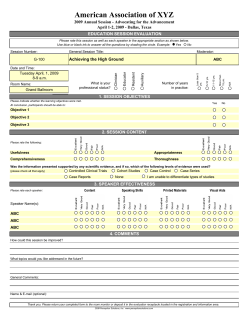
Document 267554
SAMPLE PAPER, SA – I MATHEMATICS CLASS – X Time – 3 hours MM: 90 GENERAL INSTRUCTIONS 1 All questions are compulsory. 2 The question paper consists of 34 questions divided into four sections – A, B, C and D. 3 Section A contains 8 MCQs of 1 mark each, section B contains 6 questions of 2 marks each, section C contains 10 questions of 3 marks each and section D contains 10 questions of 4 marks each. 4 There is no overall choice in the paper. However, internal choice is provided in one question of 2 marks, three questions of 3 marks and two questions of 4 marks. 5 Use of calculators is not permitted Questions Section A Q 1: Q 2: How many polynomials are there having 9 and -7 as zeroes? a) Two b) Three c) Four d) More than four Q 3: Q 4: sin40 -cos 50 =? a) 1 b) 0 c) – sin10 d) cos10 Q 5: Q 6: Q 7: The mode of a frequency distribution is obtained graphically from: a) an ogive b) a histogram c) a frequency polygon d) a bar graph Q 8: If a pair of linear equations is consistent, then their graph lines will be a) parallel b) coincident c) intersecting d) intersecting or coincident Section B Q 9: The given distribution shows the number of runs scored by some top batsmen of the world in one-day international cricket matches. Class 3000 – 4000 4000 – 5000 5000 – 6000 6000 – 7000 7000 – 8000 8000 – 9000 9000 – 10000 Frequency 5 12 13 9 5 4 6 Find the number of batsmen who scored less than 7000 runs. Q10: Express 0.254 as a rational number in the simplest form. Q 11: Q 12: Taking = 30 , verify that sin 3 = 3 sin - 4sin3 OR Q 12: Without using trigonometric tables, evaluate: sec 70 sin 20 + cos 20 cosec 70 Q 13: Write two rational numbers between and Q 14: In the given figure, PQR = 90 , PS = 10 cm, QS = 6 cm and SR = 9 cm. Calculate the length of PR. Section C Q 15: OR Q 15: Prove that is irrational. Q 16: An electronic device makes a beep after every 60 seconds. Another device makes a beep after every 62 seconds. They beeped together at 10 am. At what time will they beep together at the earliest? Q 17: Find the mean of the following data: Class-interval Frequency 0 – 10 7 10 – 20 8 20 – 30 12 OR 30 – 40 13 40 – 50 10 Q 17: Find P if the mean of the given data is 15.45 Classes Frequency 0–6 6 6 – 12 8 12 – 18 P 18 – 24 9 24 – 30 7 Q 18: If A, B and C are interior angles of ∆ABC, show that: Q 19: On his birthday Raj decides to distribute gifts to the poor people of different age groups residing near his colony. To buy suitable gifts for each age group he notes the age group and the corresponding number of people in the form of table as shown below: Age – group No. of people i) ii) 25 – 30 25 30 – 35 34 35 – 40 50 Find the mode. What lesson do you get from this? Q 20: Solve the following system of linear equations: OR Q 20: Q 21: 40 – 45 42 45 – 50 38 50 – 55 14 Q 22: If the diagonal BD of a quadrilateral ABCD bisects both B and D, prove that Q 23: If 5cot =3, find the value of Q 24: In ∆ABC, D is a point on AB, E is a point on AC and DE ll BC. If 4AD = 5DB, find ar (∆ADE) : ar (∆ABC) Section D Q 25: Calculate the median for the following data: Marks obtained Below 10 Below 20 Below 30 Below 40 Below 50 Below 60 No. of students 6 15 29 41 60 70 Q 26: Prove that: 2(sin6 + cos6 ) – 3 (sin4 + cos4 ) + 1 = 0 OR Q 26: Without using trigonometric tables, evaluate the following: Q 27: Q 28: Q 29: Find the mean, mode and median for the following data: Class Frequency 0 -10 8 10 – 20 16 20 – 30 36 30 – 40 34 40 – 50 6 Total 100 Q 30: Q 31: Q 32: Q 33: A number consists of three digits whose sum is 17. The middle digit exceeds the sum of the other two digits by 1. If the digits of the number are reversed, the number is diminished by 396, find the number. Q 34: In ∆ ABC, ABC > 90 and AD CB (produced). Prove that AC2 = AB2 + BC2 + 2BC.BD OR Q 34: In the given figure, ∆PQR is right angled at Q and the points S and T trisect the side QR. Prove that 8PT2 = 3PR2 + 5PS2. Answers Section A A 1: A 2: A 3: A 4: sin 40 – cos 50 Ans. : (b) 0 = cos (90 – 40 ) – cos50 = cos50 – cos50 =0 A 5: In ∆ABD, AB2 = 32 + 42 = 9 + 16 = 25 cot = Ans. : A 6: A 7: Ans : (b) a histogram A 8: Ans: (d) intersecting or coincident Section B A 9: The number of batsmen who scored less than 7000 runs = 5 + 12 + 13 + 9 = 39 Hence, 39 batsmen scored less than 7000 runs. A 10: A 11: A 12: OR A 12: A 13: A 14: In ∆ PSQ, PQ2 = PS2 – QS2 [Pythagoras Theorem] PQ2 = 102 - 62 = 100 – 36 = 64 PQ = = 8 cm In ∆ PQR, QR = QS + SR = (6 + 9) cm = 15 cm and PR2 = PQ2 + QR2 [Pythagoras Theorem] PR2 = 82+152 = 64 + 225 = 289 cm2 PR = = 17 cm Section C A 15: OR A 15: A 16: One electronic device makes a beep after every 60 seconds and another device makes a beep after every 62 seconds. Interval of beeping together = LCM (60 seconds, 62 seconds) LCM (60, 62) = 2 x 31 x 30 = 1860 LCM (60 seconds, 62 seconds) = 1860 seconds = They beeped together at 10 am. They will beep together again at 10 hr 00 min + 31 min = 10 hr 31 min = 10:31 am 2 60, 62 30, 31 A 17: Class – interval 0 – 10 10 – 20 20 – 30 30 – 40 40 – 50 Frequency Class mark 7 8 12 13 10 5 15 25 35 45 35 120 300 455 450 OR A 17: Class – interval 0–6 6 – 12 12 – 18 18 – 24 24 – 30 Frequency 6 8 P 9 7 Class mark 3 9 15 21 27 18 72 15p 189 189 A 18: A 19: i) Class ii) Frequency 25 – 30 30 – 35 25 34 ---- 35 – 40 50 ---- 40 – 45 42 ---- 45 – 50 50 – 55 38 14 It is good to share one’s happiness with people in need. A 20: OR A 20: A 21: A 22: Given: A quadrilateral ABCD in which diagonal BD bisects both Proof : In ∆ ADB and ∆ CDB, A 23: A 24: In ∆ADE and ∆ABC, ADE = ABC [ DE ll BC] AED = ACB [ DE ll BC] A = A [Common angle] ∆ADE ~ ∆ABC [AAA similarity criterion] 4AD = 5DB [Given] …. From (i) and (ii) ar(∆ ADE) : ar(∆ ABC) = 25 : 81 Section D A 25: Class interval 0 – 10 10 – 20 20 – 30 30 – 40 40 – 50 50 – 60 Frequency 6 9 14 12 19 10 Cumulative frequency 6 15 29 41 60 70 A 26: OR A 26: A 27: A 28: A 29: Class 0 – 10 10 – 20 20 – 30 30 – 40 40 – 50 Frequency 8 16 36 34 6 Class mark 5 15 25 35 45 = 20 + = 20 + = 20 + = 20 + 7.22 = 27.22 Median = 27.22 iii) Mode = 3 (Median) – 2 (Mean) Mode = 3 × 27.22 – 2 × 26.4 = 81.66 – 52.8 = 28.86 Mode = 28.86 Cumulative frequency 8 24 60 94 100 40 240 900 1190 270 A 30: A 31: –2 –6 0 –2 3 4 –3 6 0 5 3 4 A 32: = = = = = = Hence proved. A 33: Hence, the required number = 100 × 6 + 10 × 9 + 1 × 2 = 600 + 90 + 2 = 692 A 34: Given: ∆ABC in which To prove: AC2 = AB2 + BC2 + 2 BC.BD Proof : In ∆ADB, ADB = 90 AB2 = AD2 + BD2 ------- (i) …. (Pythagoras Theorem) In ∆ADC, ADC = 90 ….. AC2 = AD2 + CD2 (Pythagoras Theorem) = AD2 + [BC + BD]2 [ CD = BC+BD] 2 2 2 = AD + (BC + BD + 2BC. BD) = (AD2 + BD2) + BC2 + 2BC. BD = AB2 + BC2 + 2BC. BD …. From (i) Hence proved OR A 34:
© Copyright 2025







![—Not Warranting it’s adequate in ... [Sample Litigation Hold Letter from ... case, but it’s an example]](http://cdn1.abcdocz.com/store/data/000030073_2-6c36fd0490099ab95b4eb05c9c11a0b9-250x500.png)













